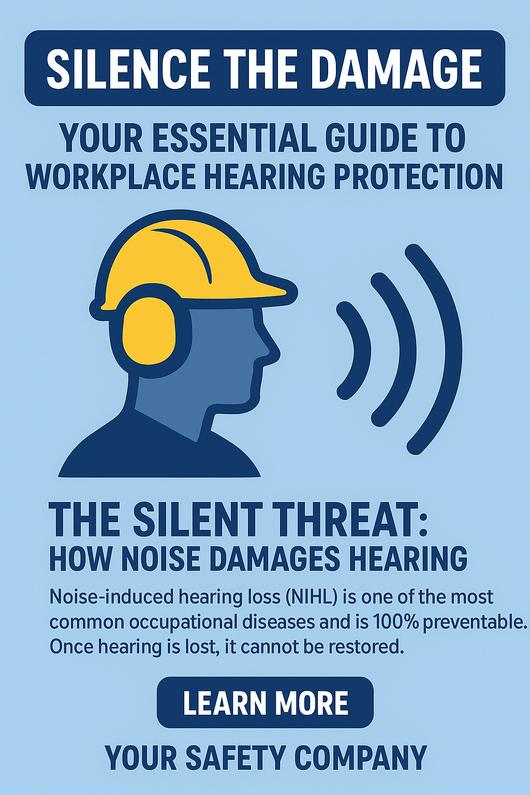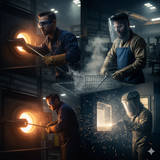Silence the Damage: Your Essential Guide to Workplace Hearing Protection
In countless workplaces, from the roaring engines of a manufacturing plant to the buzzing saws of a construction site or the constant hum of a data center, noise is an ever-present element. While we often adapt to it, prolonged exposure to excessive noise is more than just an annoyance—it's a silent, irreversible threat to one of our most vital senses: hearing.
Noise-induced hearing loss (NIHL) is one of the most common occupational diseases and is 100% preventable. Once hearing is lost, it cannot be restored. This makes effective hearing protection not just a compliance requirement, but a profound commitment to your employees' long-term health and quality of life.
At Your Safety Company, we understand that protecting your team means protecting all their senses. Let’s explore why hearing protection is critical, how to identify hazardous noise, and how to select the right solutions.
The Silent Threat: How Noise Damages Hearing
Hearing damage doesn't happen instantly (unless there's an explosive sound). It's typically a cumulative process where delicate hair cells in the inner ear are gradually destroyed by sustained loud noise.
-
Decibel Levels (dB): Sound intensity is measured in decibels. OSHA generally requires a hearing conservation program for workers exposed to noise levels at or above 85 decibels (dBA) averaged over 8 hours (the Action Level).
-
Permissible Exposure Limit (PEL): At 90 dBA over an 8-hour workday, protective measures are mandatory. The louder the noise, the shorter the safe exposure time. For example, at 100 dBA, the PEL is only 2 hours.
-
The Damage: Consistent exposure above these levels can lead to:
-
Permanent Hearing Loss: Gradual, irreversible damage.
-
Tinnitus: Persistent ringing, buzzing, or hissing in the ears.
-
Fatigue and Stress: Constant noise exposure can be mentally taxing, reducing concentration and increasing the risk of other accidents.
-
Identifying the Hazard: Is Your Workplace Too Loud?
You might not need a fancy meter to know if your workplace poses a noise risk. A good rule of thumb:
-
If you have to raise your voice significantly to be heard by someone an arm's length away, the noise level is probably above 85 dBA.
-
If you have to shout to be heard by someone an arm's length away, the noise level is probably above 90 dBA.
For precise measurements and to establish a formal hearing conservation program, professional noise monitoring is required.
Selecting the Right Protection: Types and Ratings
Once a noise hazard is identified, the next step is selecting appropriate hearing protection. All hearing protection is rated by its Noise Reduction Rating (NRR), measured in decibels. A higher NRR indicates greater noise reduction.
-
Earplugs:
-
Types: Disposable foam, reusable silicone, or custom-molded.
-
Benefits: Lightweight, highly portable, often more comfortable in hot/humid environments or when wearing other head PPE (like hard hats or welding helmets). Can offer high NRR ratings.
-
Considerations: Require proper insertion for effectiveness; hygiene is important for reusable types.
-
-
Earmuffs:
-
Types: Headband style, cap-mounted (for hard hats), or neckband style.
-
Benefits: Easier to put on and take off, often more comfortable for intermittent use, and generally provide a consistent seal. Available in various NRR levels.
-
Considerations: Can be bulky, interfere with other head PPE, and may cause heat buildup around the ears.
-
-
Bands (Canal Caps):
-
Types: Soft tips attached to a lightweight band.
-
Benefits: Offer convenience for intermittent use, as they can be hung around the neck when not needed.
-
Considerations: Typically provide lower NRR ratings than plugs or muffs.
-
Ensuring Effectiveness: Fit, Compliance, and Conservation
Having hearing protection available isn't enough; it must be worn correctly and consistently.
-
Proper Fit: The effectiveness of any hearing protector relies entirely on a proper seal. Employees must be trained on how to correctly insert earplugs or position earmuffs. Fit testing can verify individual effectiveness.
-
Comfort & Choice: Offering a variety of earplugs and earmuffs can increase wearer acceptance and compliance.
-
Hearing Conservation Program: For workplaces with noise levels above 85 dBA, a comprehensive program includes:
-
Noise Monitoring
-
Hearing Protection Provision
-
Employee Training
-
Audiometric Testing (Annual Hearing Tests)
-
Program Evaluation
-
Your Safety Company: Protecting the Sound of Safety
Noise-induced hearing loss is a silent epidemic that can be completely prevented with the right knowledge and the right equipment. By implementing a robust hearing conservation program and providing appropriate hearing protection, you are safeguarding your employees' long-term health and maintaining productivity.
At Your Safety Company, we offer a comprehensive selection of earplugs, earmuffs, and related hearing protection accessories with various NRR ratings to suit any industrial environment.
Don't let preventable noise damage impact your team. Visit yoursafetycompany.com today to explore our full line of hearing protection solutions.
Recent Posts
-
More Than Goggles: The Specialized Eye Protection Needed for High-Heat Industrial Environments
In facilities that process metal at extreme temperatures, eye safety is a complex, multi-layered cha …12th Nov 2025 -
Double Defense: Why Cut and Impact Protection is Critical for Material Handling
In facilities that deal with heavy metal parts, sharp edges, and complex machining, a standard work …11th Nov 2025 -
Beyond the Flame: Why NFPA 2112 FR Apparel is Non-Negotiable
In high-risk industrial settings—from petrochemical plants and utilities to metal processing and hea …7th Nov 2025



